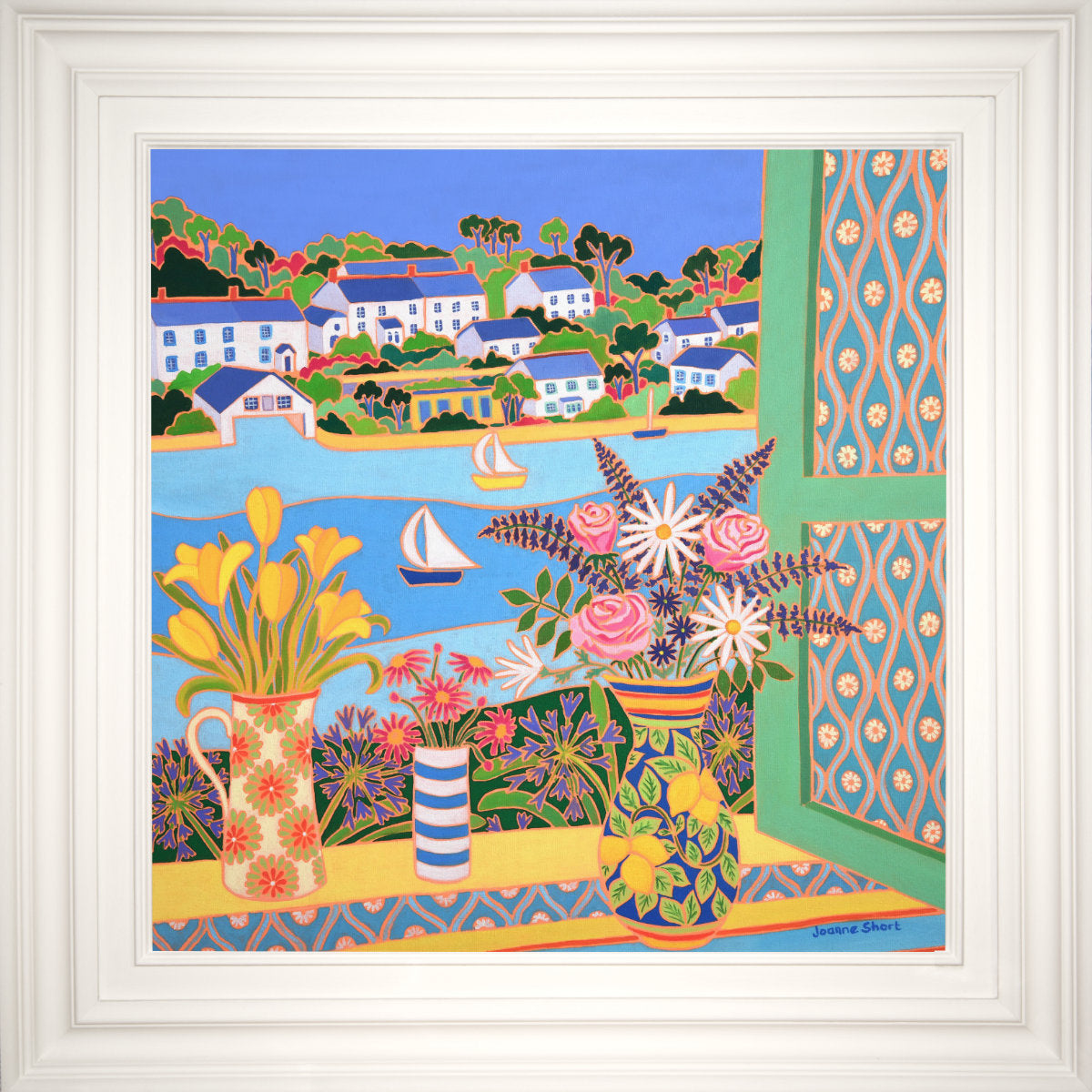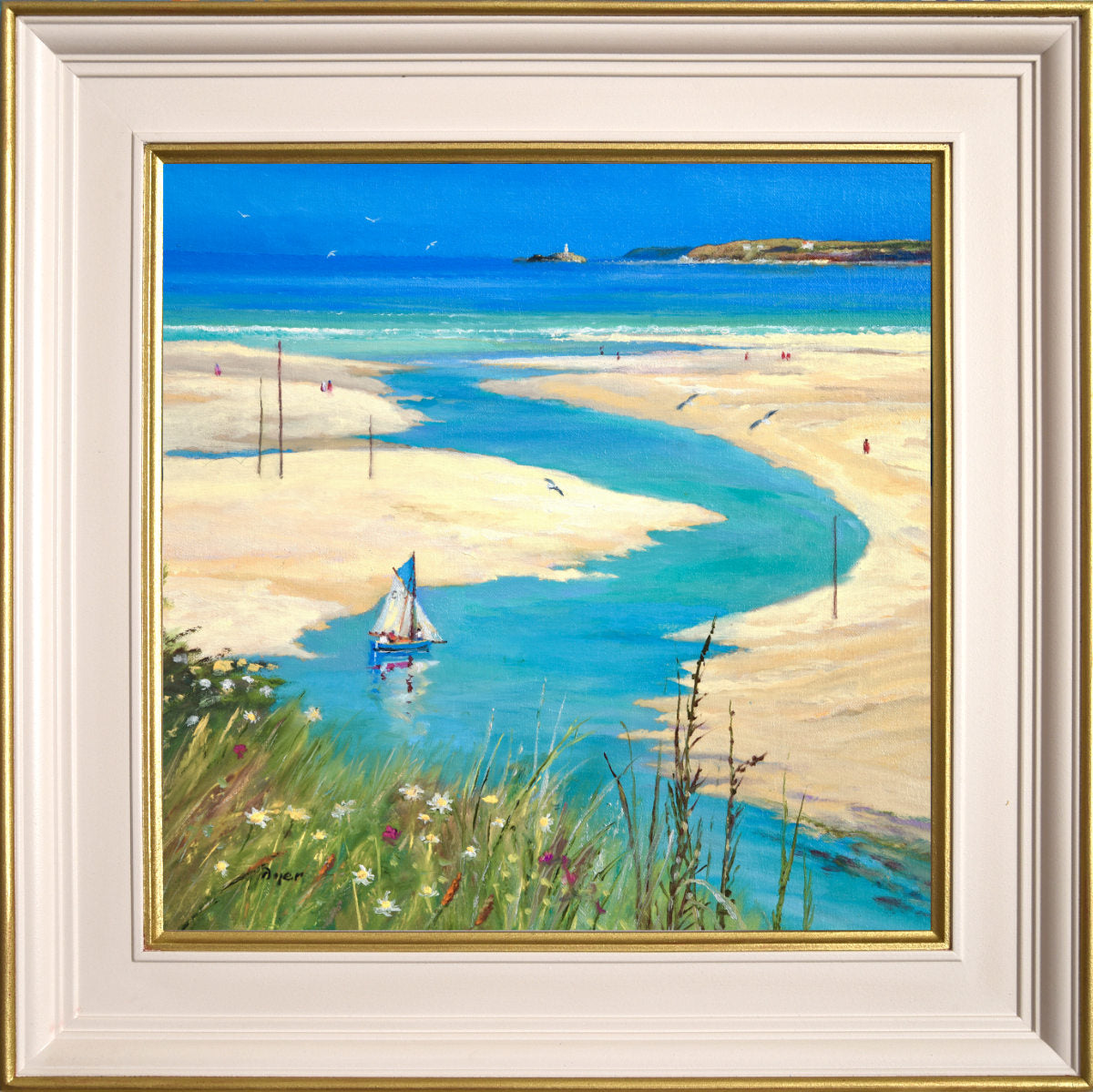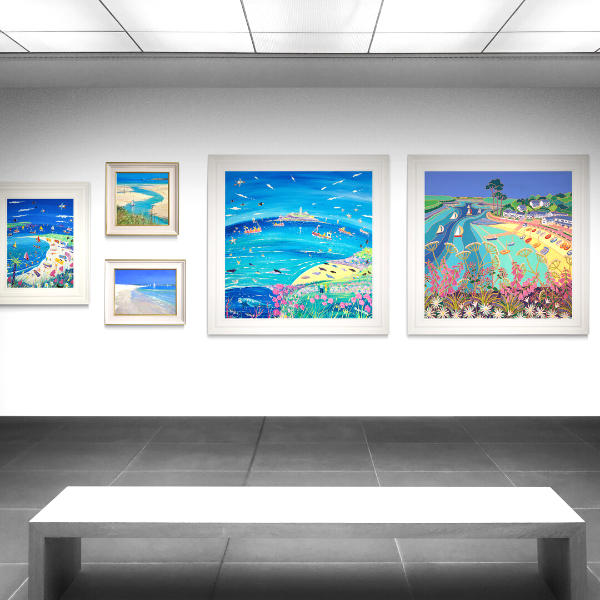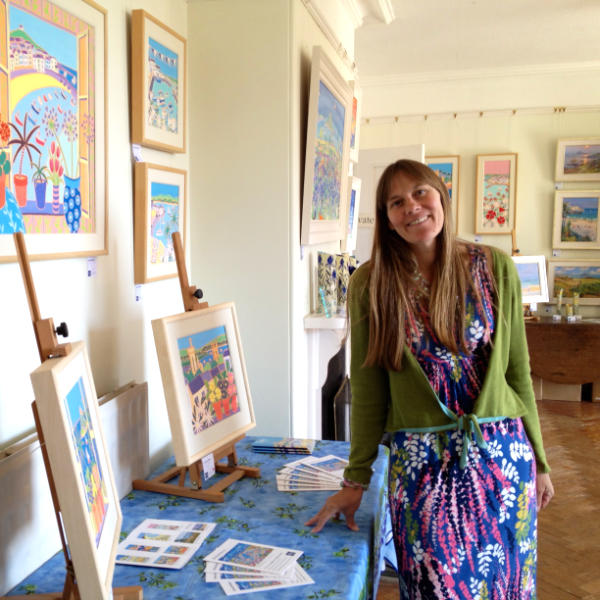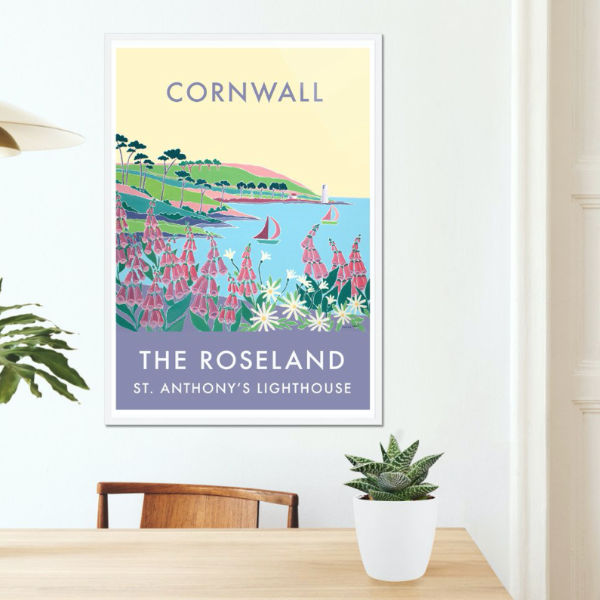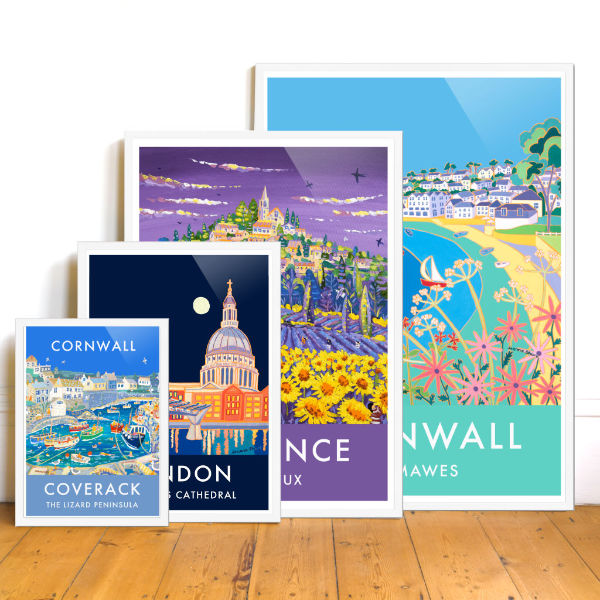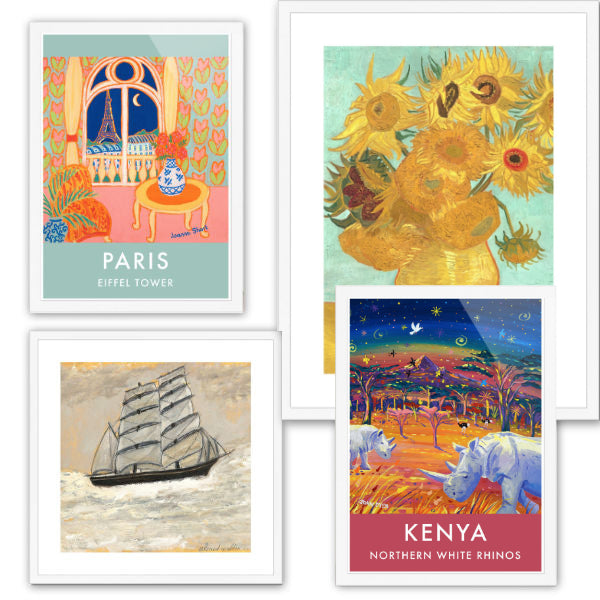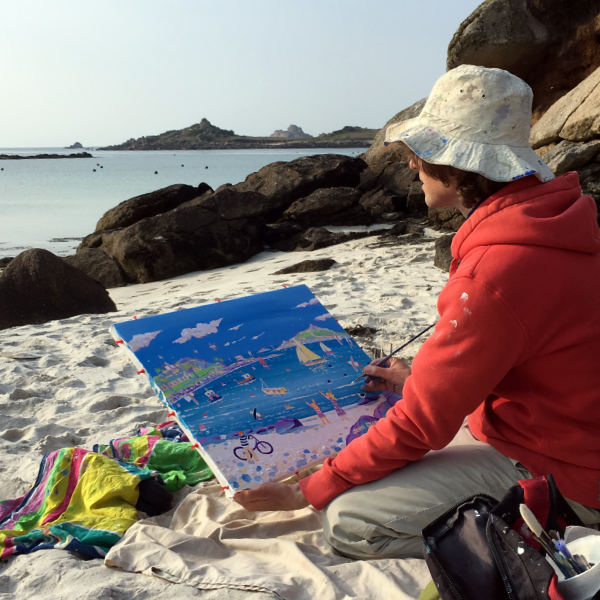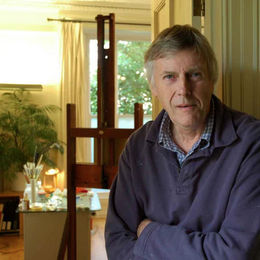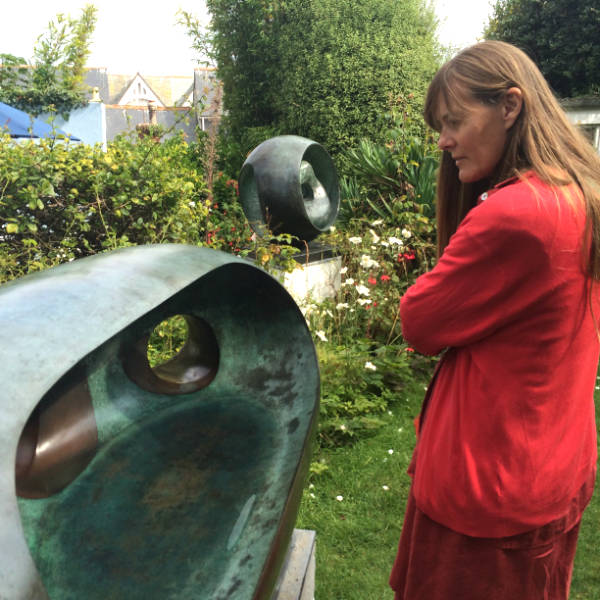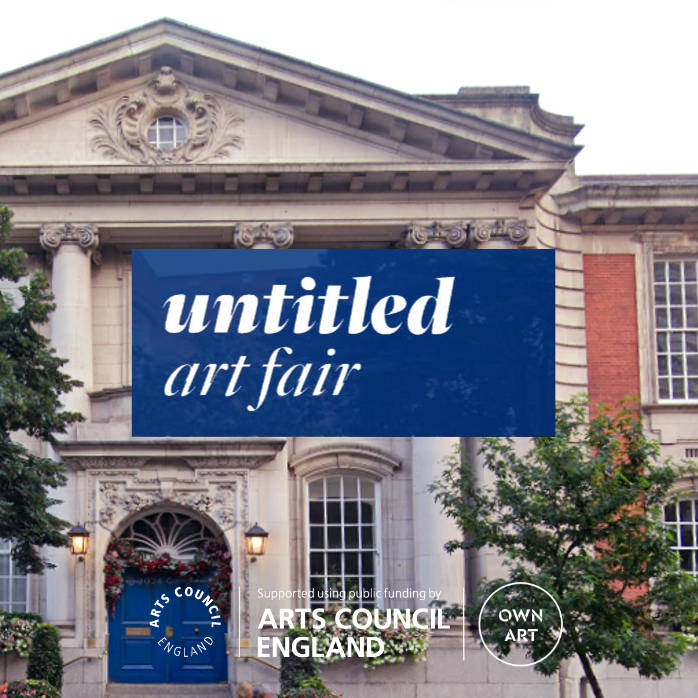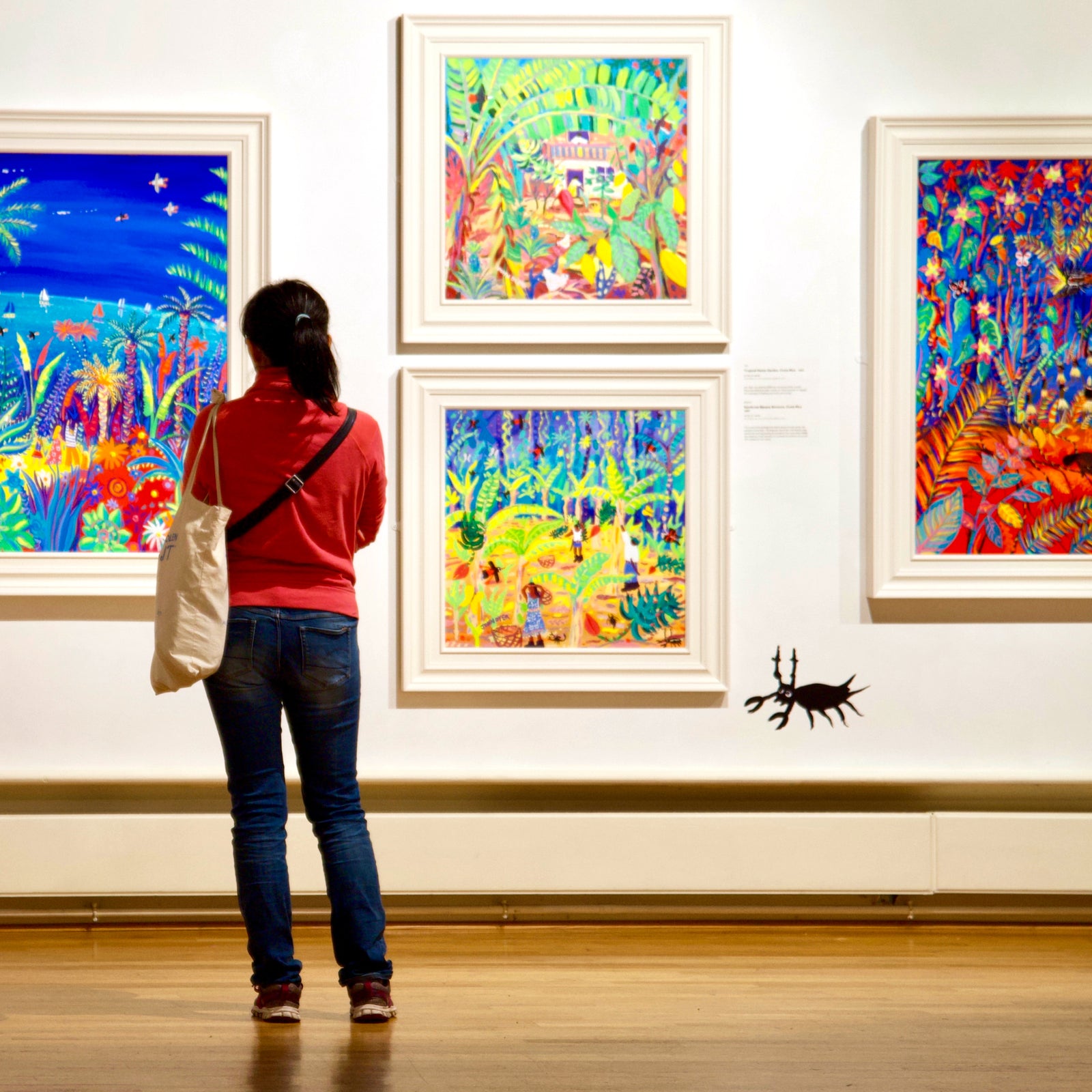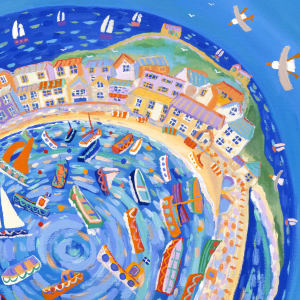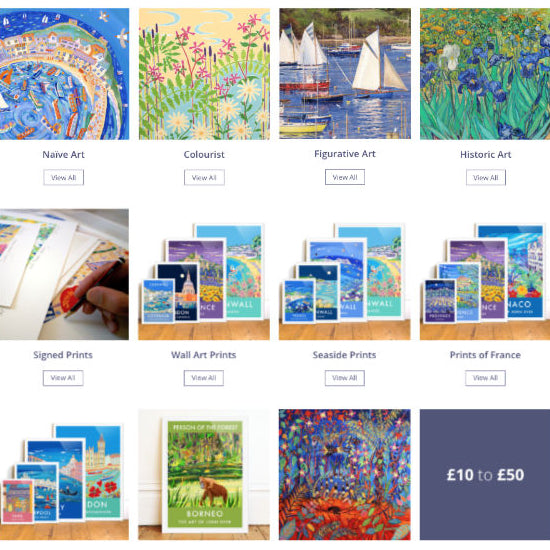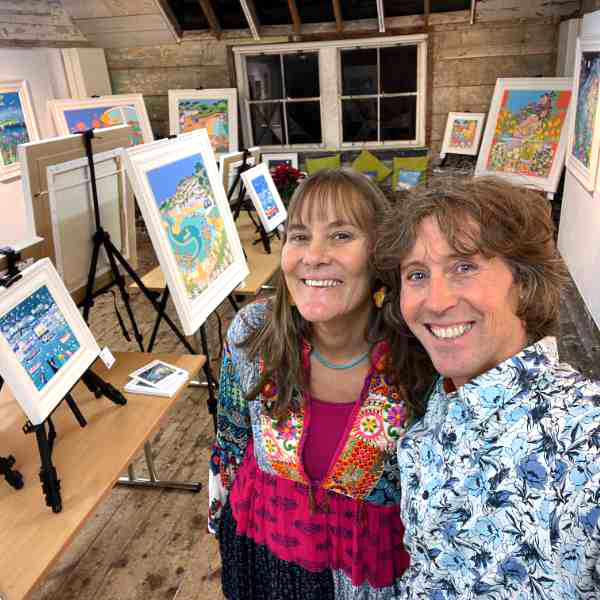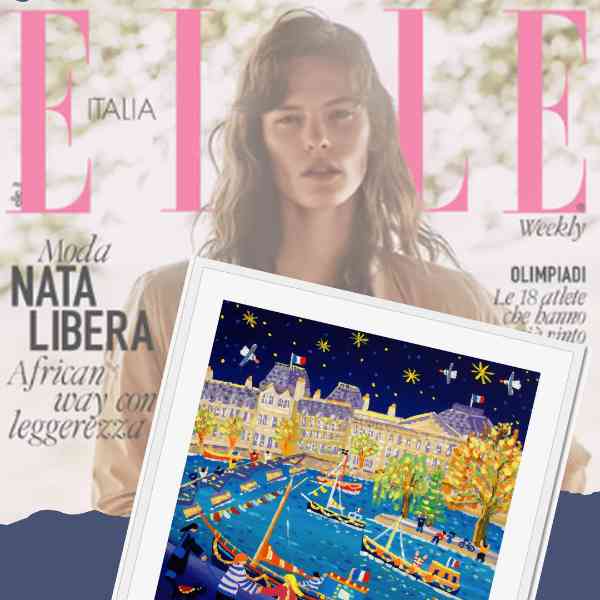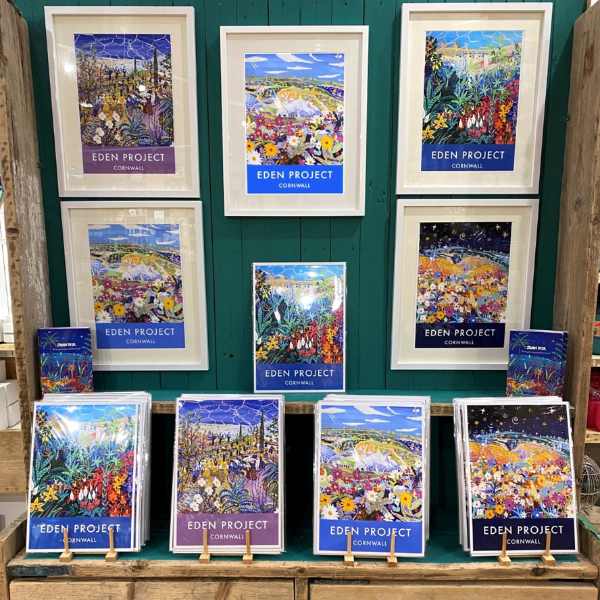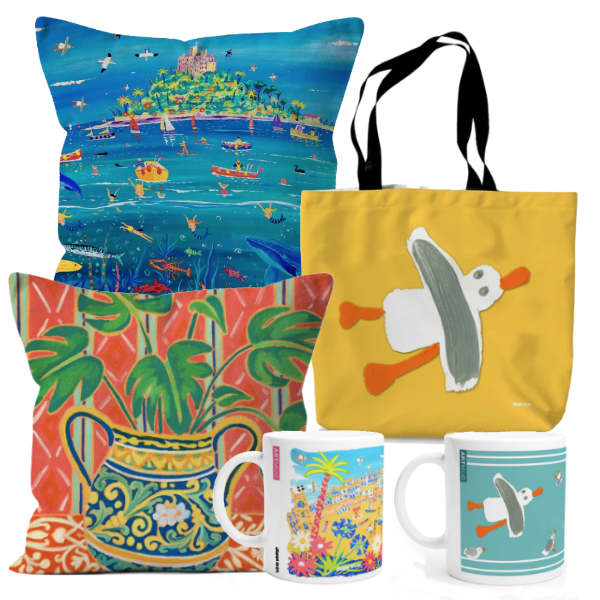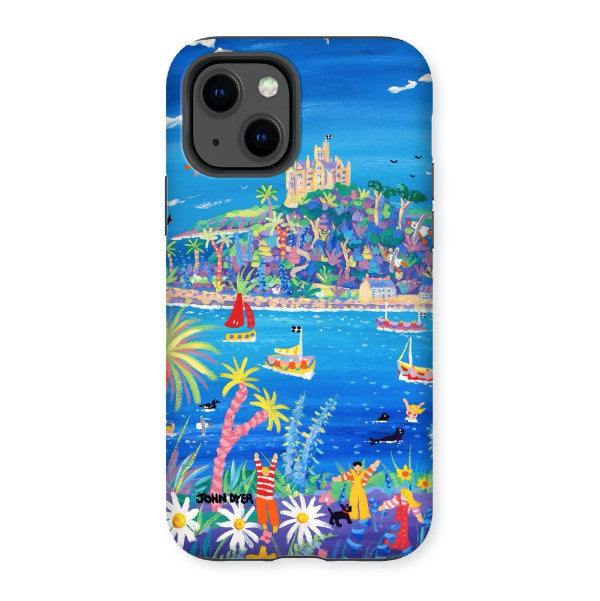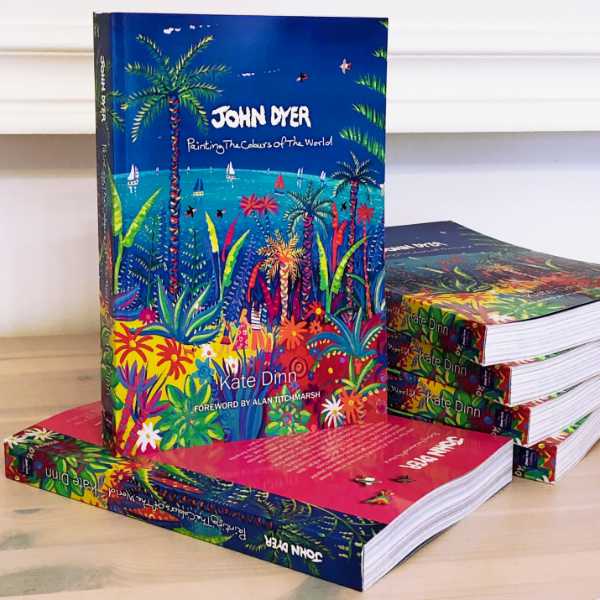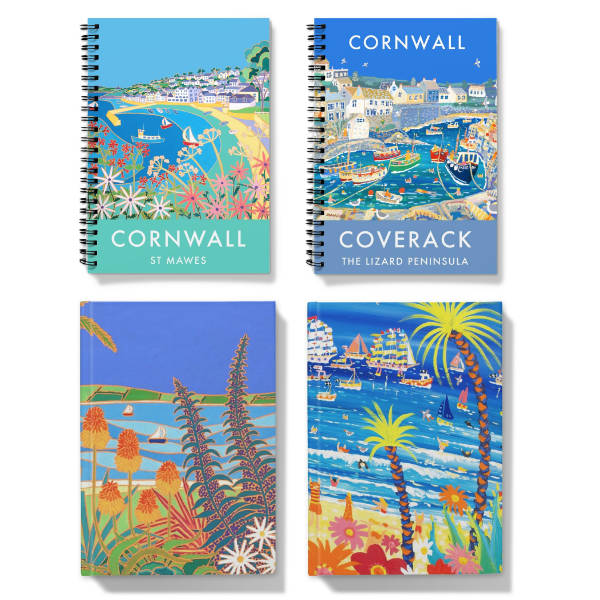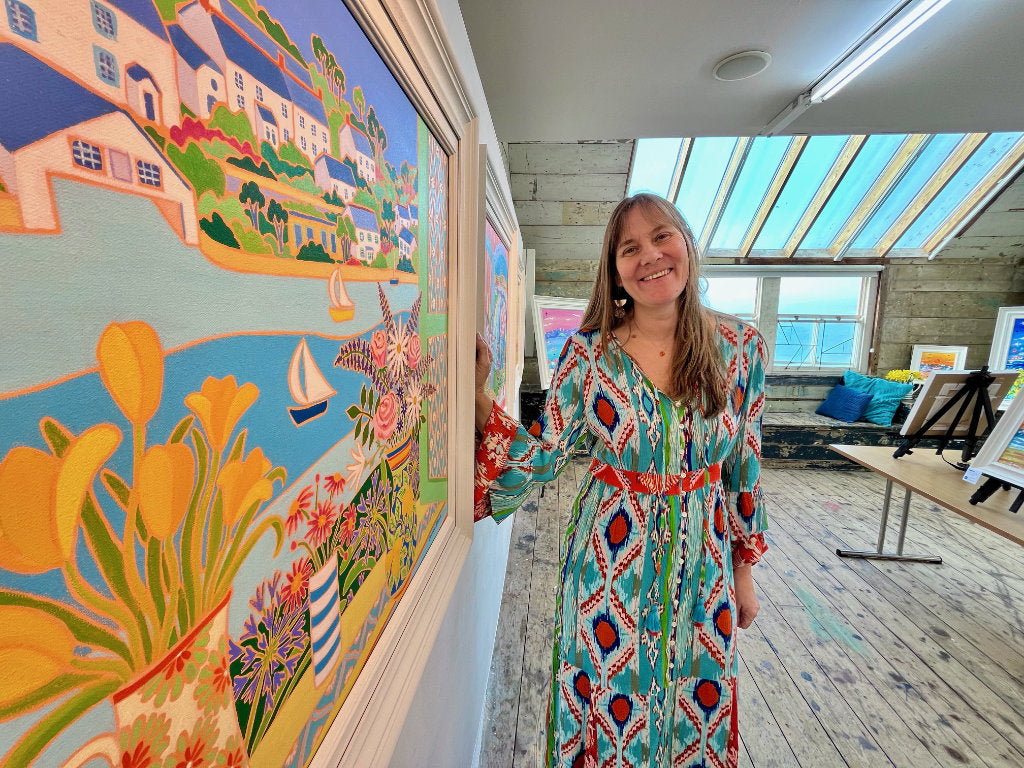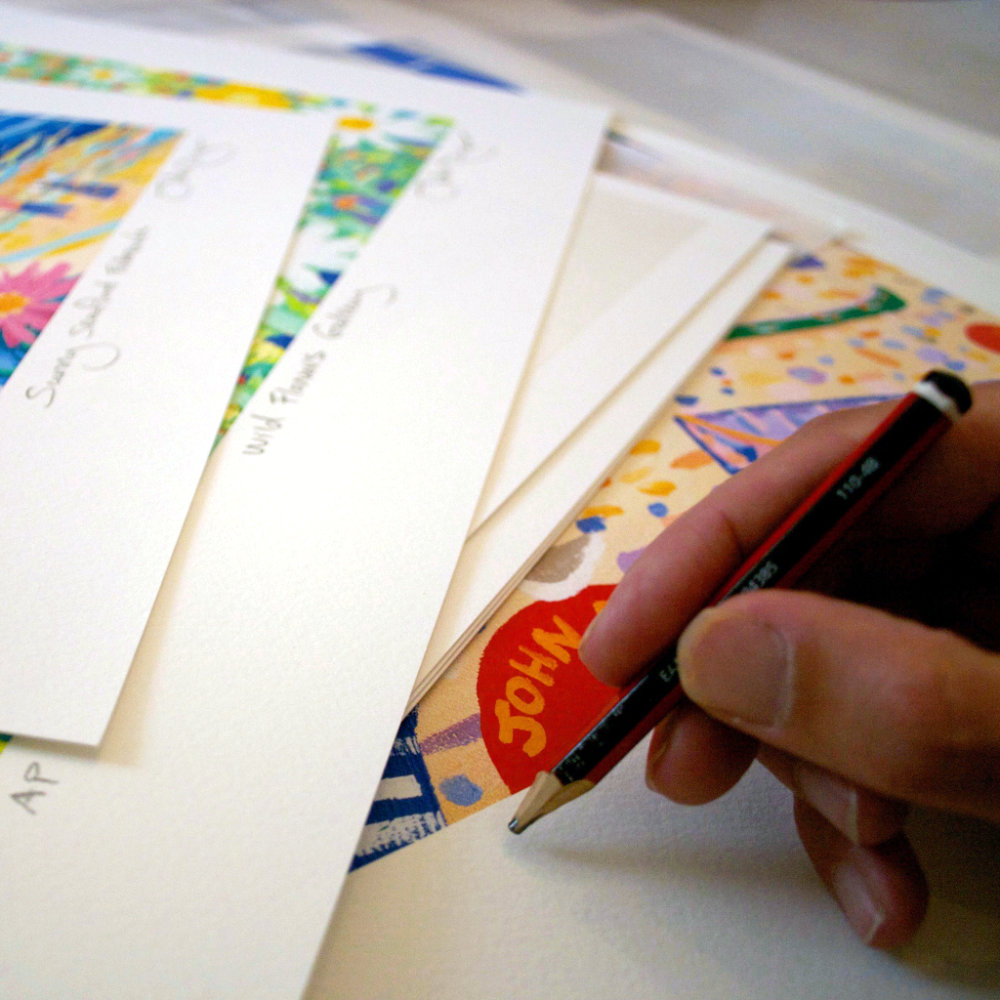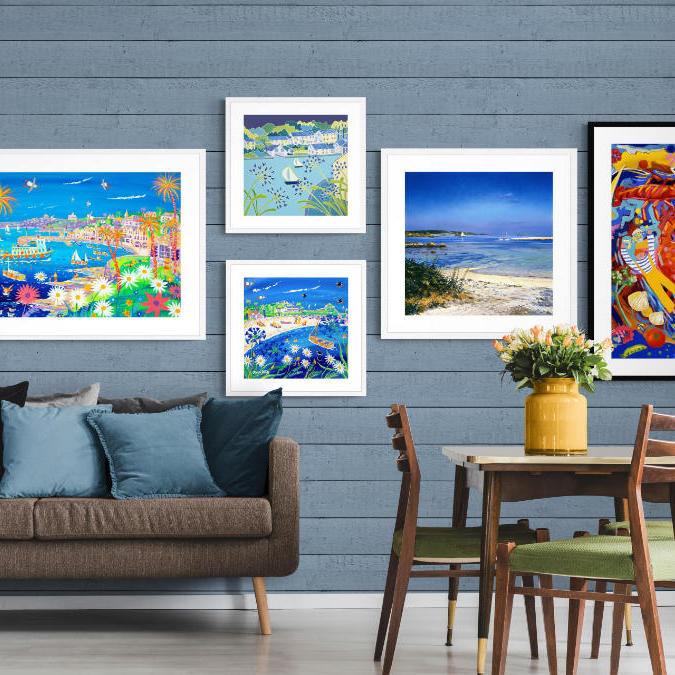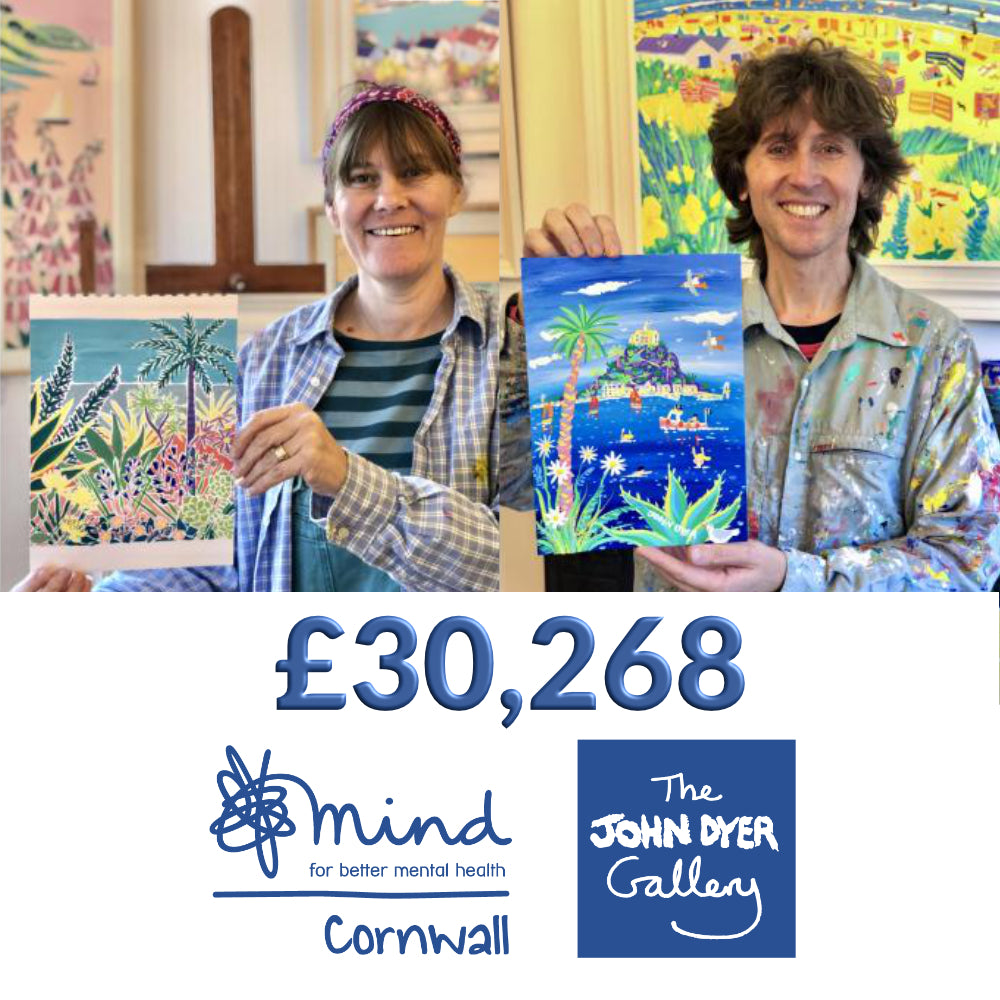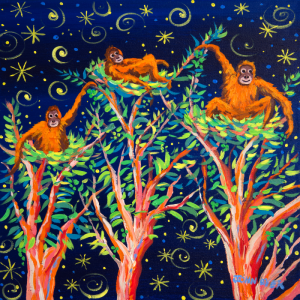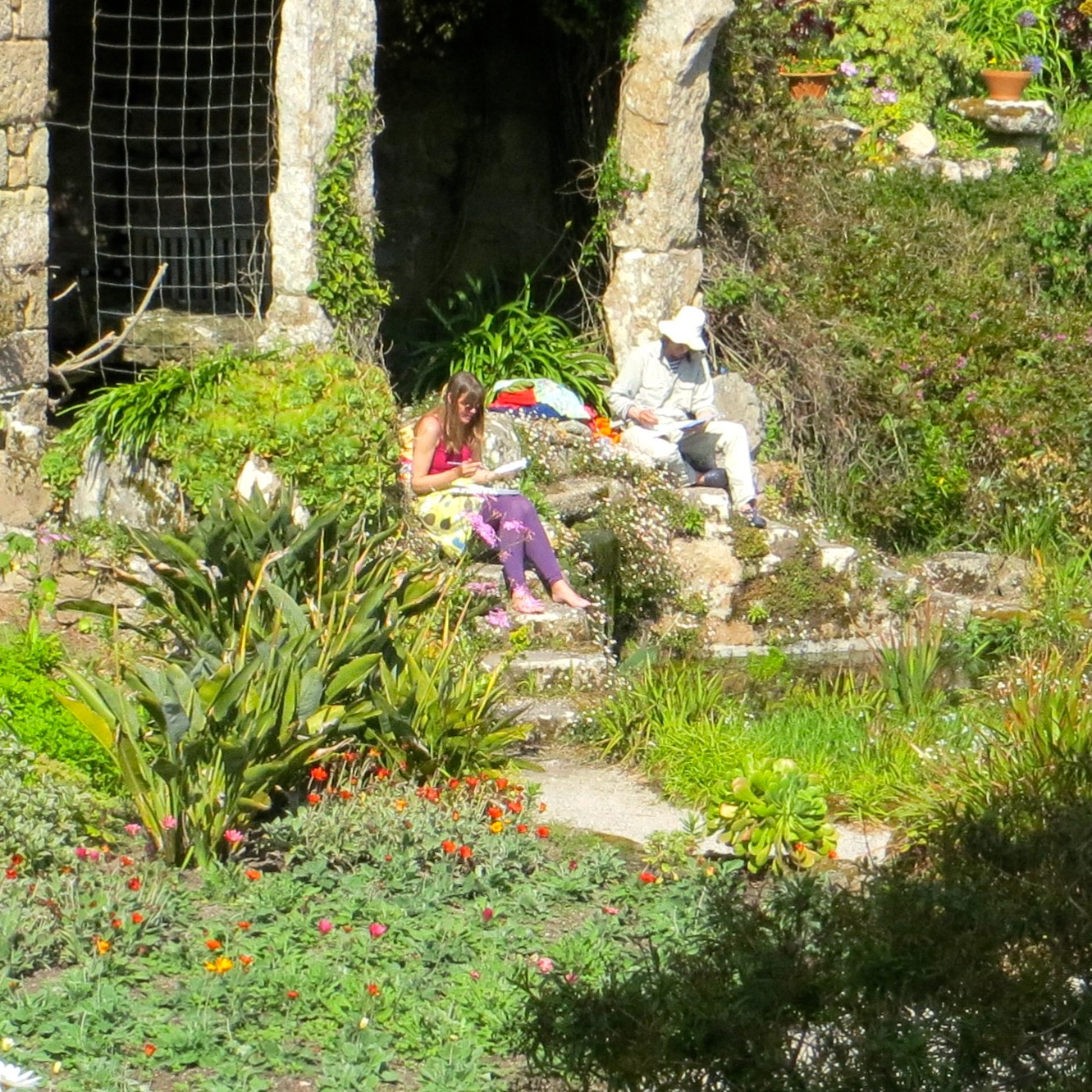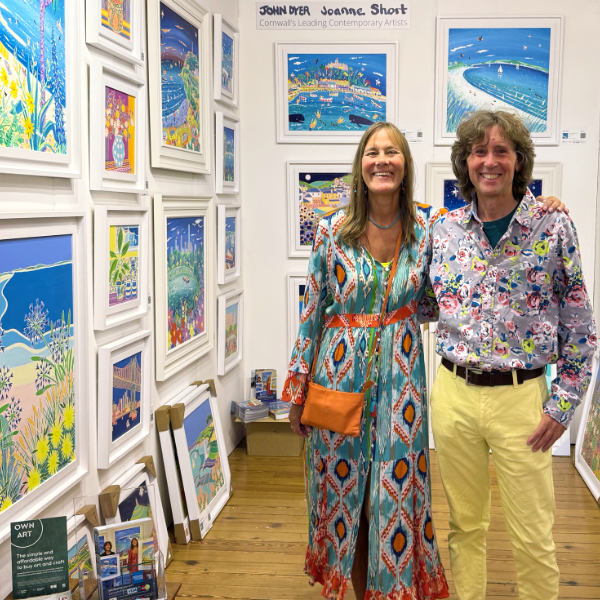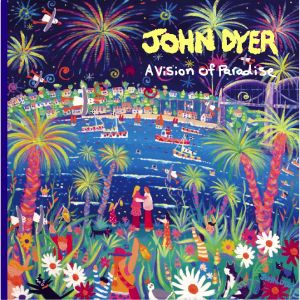
An Innocent Eye
"JOHN DYER is one of Cornwall’s best loved artists. His vibrant paintings are full of warmth, energy and life. Through art cards, prints and merchandise his work gives pleasure to people around the world.
He has captured the vitality of Cornwall, whether it is a tall ship’s race, the achievements of the Eden project, or Falmouth’s welcome to Ellen McArthur on her triumphant return from her record breaking voyage.
John Dyer has a love of gardens and the environment. As a painter in residence he has recorded the spirit of the magnificent gardens at Trebah, Glendurgan, Helligan, Trelissick, St Michael’s Mount and Tresco.
There is an innocence and freshness to John Dyer’s art that follows a tradition in Cornwall that includes the work of Alfred Wallis, Christopher Wood, Fred Yates and Bryan Pearce. Rather than trying to record what he sees, John sets out to capture the ‘essence’ of his subject. The ‘essence’ of seagulls, cats, dogs, bobbing boats, or exploding fireworks communicate far more strongly through John’s brushstrokes than they would if drawn more traditionally. It is this ability to capture the ‘essence’ of what is important that seems to appeal to those who have shown great vision and originality in their own careers, such as Tim Smitt, Alan Titchmarsh or Kim Wilde.
John began as a photographer, publishing his first landscape in a magazine at the age of twelve. By the time he was a student in his foundation year at Falmouth College of Arts he was selling images to Athena, the country’s leading print publishers.
After his foundation year John went on to gain a BA Honours degree in Graphic Design at Middlesex Polytechnic in London. As the best student of his year he won a travelling bursary from Thames Television to photograph and record the Amazon Rainforest.
John was amazed by the colour and variety of the plant life he saw there, but became dissatisfied with photography as a medium for capturing the richness he saw. On his return he took up painting and never looked back. The visit to the Amazon also gave him the desire to return to Cornwall, the place where he had grown up. As John describes: “When I returned to Cornwall after my experience of the Amazon I noticed what I had taken for granted for years. The plants growing in Cornwall, palms on the sea front, tree ferns and cactus mixed together in gardens - places like Trebah Garden and The Lost Gardens of Heligan were being rediscovered. Taking a boat up Frenchman’s Creek was a déjà vu experience for me. Large fallen trees half submerged in the water, foliage tumbling down steep slopes, birds echoing in the undergrowth, this was as Amazonian as it got for me and I realised Cornwall had it all.’
Before he begins a painting John deliberates long and hard, working out how to interpret the subject into his own personal vision and capture that ‘essence’ that will trigger emotions in the viewer. When satisfied he works extremely quickly to capture the spontaneity of the moment.
John’s art has an ability to lift the spirits. I have watched the excitement and delight of small children and families viewing his paintings when on display at Falmouth Art Gallery. I have observed the transformation of the atmosphere brought about by an exhibition of his paintings. John Miller and Matisse’s late work were also transforming. It seems almost impossible to view an exhibition of these three artists’ work and stay in a bad mood!
The artist Jules Flandrin wrote about his friend Matisse’s work: ’The essential thing about Matisse’s painting is not to judge it except by eye. You have to look at it as you would look at the sunshine through a window. And then it works, I promise you.’
John’s paintings are also like ‘sunshine through a window’. I once asked him if he ever painted anything that he didn’t love. He thought long and hard before replying firmly: ‘No, never!’, This may be the secret of his success, for the art of John Dyer has the magic to touch lives."
Brian Stewart
Celebrations
Falmouth’s welcome for Ellen MacArthur’s triumphant return was beamed by satelite around the globe. She had just smashed the record sailing non stop single handed around the world. Exhausted after the the 27,000 mile journey she was met by a frenzie of sailing vessels at the mouth of the River Fal. John was on hand to record the event on canvas from the vantage point of Pendennis Castle. His painting conveyed the atmosphere of the day far better than any photograph and the work sold within 30 minutes of being exhibited.
Ellen landed at the new National Maritime Museum Cornwall. John had previously been commissioned to paint the opening of this impressive landmark building designed by M.J.Long in 2002.
John was also the natural choice for a commission by Falmouth Art Gallery to mark the 200th anniversary of Brunel. Gateway to Cornwall (front cover), shows the celebrations in 2006 at the Royal Albert Memorial Bridge at Saltash. Brunel’s Great Western Railway opened Cornwall to tourism and the visit of artists, creating colonies such as The Newlyn School and the St Ives painters.
The vitality and energy conveyed by John’s fluid brushwork have made him the perfect artist for capturing the joy of a celebration.
The Eden project
“A fabulous collection which perfectly epitomises Eden” Tim Smit
THE phenomenal success of Eden is well chronicled and, as painter in residence, John has played his part. In November 2000 Sue Hill, the art director of the Eden Project, offered John Dyer a painting residency, and began by showing him around Watering Lane Nursery, where over 20,000 plants were being prepared in readiness for their location to the biomes. Specimen plants from West Africa, Amazonia and Oceania stood waiting to be inspected.
John was impressed by the Balsa trees, Chinese plants, palms, oranges, lemons, cacti, and sugar cane. He realised at once that he was recording something very special and his excitement can be seen in the series of paintings made at Watering Lane.
His first visit to the Biomes was in December 2000. Since then he has continued to paint the amazing story of Eden.
Sue Hill cleverly summed up John’s contribution: ‘John’s work is pure painted joy – unbuttoned, jumping up-and-down, salty, earthy, laugh-out-loud, natural energy. His pictures make you want to touch felty leaves, squeeze fat fruit, push your nose into flowers and breathe deeply. It’s no surprise that his paintings are popular the world over.’
As John says: ‘The Eden Project is a showcase for nature and exists not only to entertain but more importantly to educate and remind us to respect the natural world and plant life in it. I hope that my paintings, in some way, will reinforce Eden’s message of how marvellous nature is and help to create a sense that this must be conserved for us all.’
Garden Delights
CORNWALL has some of the best and most exciting gardens in England. John has captured the ‘essence’ of them all. He has painted the public gardens at Trebah, Glendurgan, Helligan, Trelissick, St Michael’s Mount and Tresco Abbey.
John has also recorded a great number of private gardens in Cornwall and beyond. Perhaps the most famous of these is the unique series of paintings undertaken in 2002, exploring Barleywood’, Alan Titchmarsh’s then Hampshire garden used for the BBC’s Gardener’s World programme.
The paintings John produced were all the more poignant to Alan and his wife Alison, for they were to leave Barleywood at the end of the year after twenty years of living and gardening there. The images were reproduced as a successful series of limited edition prints. These were sold together at Eden in 2003 with Alan’s new autobiography Trowel and Error, raising money for Gardens for Schools, which Alan and his wife set up to enable schools to build much needed gardens.
John also captured the creation of a wonderful tropical garden designed by rock star and TV presenter Kim Wilde at her home in Hertfordshire. Kim wrote of John: ‘Each day he arrived early, and painted huge canvases full of vibrant colour, and every day we were entranced. Our children were captivated not only by the paintings, but by John himself who took time to involve them. The results were magical, and perfectly captured the special atmosphere we feel living in this beautiful place. have always had immense respect for anyone who chooses to take time to interpret our world for us through painting, and feel especially privileged to have hosted such an inspired artist in our back garden!’.
Starry Starry Nights
THE romance of John Dyer’s art is most evident in his nocturn paintings. As a child in Cornwall he was in awe of the moon and the stars, and this magic was rekindled during his visit to the Amazon jungle in 1989.
As night fell the Amazon came alive with the music of frogs and insects, and the landscape could be viewed without light pollution. The excitement this generated inspired John to become a painter rather than a photographer and to devise a whole new visual language to capture the paradise he saw.
In Cornwall the scattered lights of houses created patterns reminiscent of Kandinsky. John’s impressive swirling skys were influenced by his painting of the comet Hale-Bopp in 1997, which he captured on canvas from Mousehole, a town famous for its romantic lantern parades.
John recalls: ‘I was standing amongst the palm trees on that clear starry night when I saw the breathtaking sight of the comet Hale-Bopp. As the comet blazed across the night sky it put the curve of the earth and the vast expanse of sky into my mind and this combined with all the magical colours of Cornwall has influenced my night paintings from that time.'
Tresco Abbey Garden
JOHN first went to Tresco in May 2001 with his wife, the artist Joanne Short. They were invited to paint Tresco Abbey Gardens by owners Lucy and Robert Dorrien-Smith.
John was amazed by the wide array of tropical plants growing there. The gardens were first built in the 19th century by Augustus Smith and have been added to and improved, particularly in recent years under the garden’s curator, Mike Nelhams. Because of its warm climate Tresco is able to grow lush plants from the Mediterranean, South Africa, Chile and Mexico. The rich colours on show inspired both artists to produce some of their best work, and as John described they ‘painted like children in a sweet shop’.
Invariably during these private viewings of the gardens they would encounter Topper and Batty with Frank in hot pursuit. Topper is a small white dog and Batty a black Labrador who live in the abbey with Frank, who before his retirement was gardener there for many years. The trio appear in many of John’s Tresco paintings, Frank being easily recognisable by his walking stick.
John said: ‘I always find the island inspiring, especially in the summer months when the seas are brilliant blue, flowers bloom all over the white sand dunes, and the Tresco Abbey Gardens are awash with the most brilliant and exciting forms and colours.’
Sun Sea and Fancy Free
JOHN loves going out into the landscape and watching the world around him. Cornwall can be a busy place in the summer and John delights in conveying the buzz of Cornish beaches in the height of summer.
John commented: ‘When the sun comes out the landscape fills with colour, the light pours over the vegetation filling each leaf with radiant colours, and cool waters into Mediterranean delights. I love living in Cornwall and I love painting.
I spend every day that I can out and about painting what I see - bright colours, sunshine and fun, small dogs with damp noses, peeling paint and peeling people, shells on the beach, sea spray in the air, jazz bands in bandstands, picnics on cliff tops, bright coloured smocks, cactus plants on walls, and banana plants in the park, small coves, surf and still waters, the red moon on the horizon and stars, comets, and crickets; lighthouses and cottages, fishing boats and floats, clear air and big skies, seagulls, greedy gulls, and silly gulls, buckets of crabs, fishermen in yellow oilskins, cats steeling fish, sea pinks and mermaids, ferry boats and flags.
These are just some of the things that inspire my paintings. My work documents my trips out into the landscape and the things that I enjoy. Through my paintings I hope to lift peoples spirits and provide an optimistic outlook on life.’
Travels Abroad
JOHN Dyer’s work is popular throughout the world. He has undertaken painting projects on the Amazon rainforest, Spain, Brittany, Loire Valley, Provence, Côte d’Azur, Costa Rica, the Philippines and South Australia.
Many of these visits have been led by John’s interest in the environment. During April 2004 John Dyer was resident artist at the International Rice Research Institute at Los Baños in the Philippines. There he studied the ethno-botanical relationships surrounding the crop rice. The resulting paintings were shown at Eden.
He was asked in 2003 by INIBAP at Costa Rica to paint images for their annual report. John’s portrayal of traditional banana agriculture in Costa Rica lavishly illustrated the animal life that shares the space with the growing crops. The Latin American insect fauna made a big impression, particularly the scorpions. John recalls: ‘I was asked to paint bananas, and thought it would be great to see them in their natural habitat; before long I found myself in the jungle surrounded by bugs’.
John was accompanied in the jungle by presenter and film maker David Ashe who said: ‘We stared each day at 5.30 am, as dawn broke, and the night sounds of the jungle quietened down. While John painted I watched, intrigued by how he would stand in front of a blank canvas and appear to perform a mystical dance waving a dry paintbrush around, as he began to ‘see’ what the painting might become. I was fascinated to watch the colour appear and the literally brilliant images emerge’.
The conservation area created at Banrock Station in South Australia led to an invitation to John Dyer to paint the plant and animal life that has thrived since an active ecology programme was undertaken by Hardy Wines. The Banrock Station paintings were displayed at the Eden Project. .


